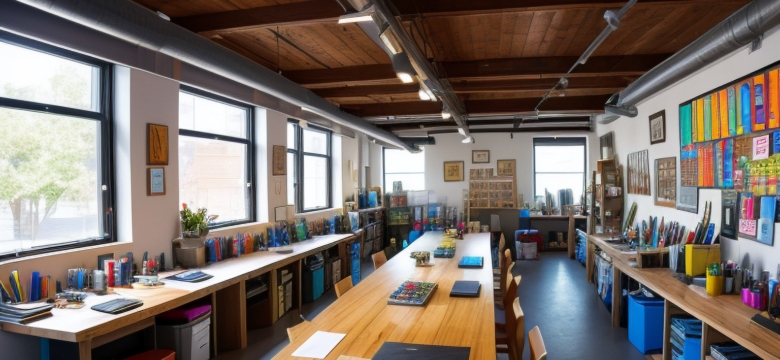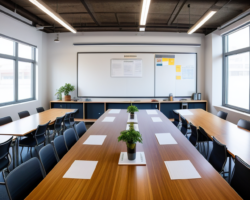Are you ready to transform your workshops into something truly memorable? Explore innovative workshop ideas designed to enhance learning and engagement, setting the stage for impactful experiences. Imagine walking into a room buzzing with energy, where every participant is eager to dive in. This is the magic of well-planned workshops! Not only do they provide valuable knowledge, but they also create an atmosphere that fosters collaboration and creativity.
Consider the first impression your workshop makes. Think of it as the opening act of a concert; it needs to grab attention and get everyone excited. By incorporating interactive icebreakers, you can break down barriers and encourage participants to connect right from the start. This sets a positive tone and creates a sense of community. But it doesn’t stop there! Hands-on activities are crucial as they allow participants to engage actively, applying concepts in real-world scenarios. This approach enhances retention and understanding, making the learning experience not just informative but also enjoyable.
Moreover, integrating technology into your workshops can elevate the experience to another level. Imagine using virtual collaboration tools that enable seamless communication, especially in today’s hybrid working environments. With these tools, participants can collaborate effortlessly, making teamwork feel like a breeze. By the end of your workshop, you’ll not only have imparted knowledge but also sparked enthusiasm and a desire for continuous learning.
Interactive Icebreakers
Starting a workshop on the right note is crucial, and that’s where come into play. These activities are like the warm-up exercises of a workout; they get everyone moving and engaged before diving into the meat of the session. Imagine walking into a room full of strangers, feeling a bit anxious, and suddenly being invited to share a quirky fact about yourself. It’s a simple yet effective way to break down barriers and create a friendly atmosphere.
One of the best things about icebreakers is their versatility. You can tailor them to fit any group size or setting. For instance, a quick round of Two Truths and a Lie can spark laughter and conversation, while a Speed Networking activity can help participants make valuable connections in a short amount of time. The goal is to foster a sense of community, making everyone feel included and valued right from the start.
Consider these engaging icebreaker ideas:
- Human Bingo: Create bingo cards with interesting traits or experiences, and let participants mingle to find matches.
- Story Circles: Form small groups where each person shares a brief story related to a given theme.
- Common Ground: Challenge participants to find three things they all have in common, fostering dialogue and connection.
Ultimately, the right icebreaker can transform the energy of your workshop, setting a positive tone that encourages collaboration and creativity. So, why not kick things off with a little fun? It’s a small investment of time that pays dividends in engagement and interaction!
Hands-On Activities
When it comes to workshops, are the secret sauce that turns a mundane session into an unforgettable experience. Imagine diving into a task where you can roll up your sleeves and get your hands dirty—this is where real learning happens! These activities not only make the content more relatable but also boost participant engagement significantly. After all, who doesn’t love a good challenge that allows them to apply what they’ve learned in a practical setting?
By incorporating hands-on exercises, you’re essentially creating an environment where participants can experiment, explore, and innovate. This approach enhances retention and understanding, as they’re not just passively absorbing information; they’re actively participating in their learning journey. For example, consider using simulations or role-playing scenarios that mimic real-world situations. These methods encourage participants to think critically and problem-solve in a safe space.
Moreover, hands-on activities can be tailored to fit various learning styles. Whether you’re dealing with visual learners who thrive on seeing concepts in action or kinesthetic learners who prefer to touch and manipulate materials, there’s something for everyone. To ensure you’re hitting the mark, you might consider gathering feedback on which activities resonate most with your audience.
In summary, hands-on activities are not just a trend; they are a vital component of effective workshops. They transform theoretical knowledge into practical skills, making learning both enjoyable and impactful. So, are you ready to shake things up and bring some excitement into your next workshop?
Group Projects
Group projects are like a breath of fresh air in the often monotonous world of workshops. They not only promote teamwork but also allow participants to learn from each other’s unique perspectives. Imagine a group of individuals, each bringing their own strengths and ideas to the table, collaborating to solve a common challenge. This dynamic not only fosters a sense of community but also enhances the overall learning experience.
When structured effectively, group projects can lead to remarkable outcomes. They encourage participants to engage in critical thinking, as they navigate through different viewpoints and approaches. Additionally, working in teams helps individuals develop essential skills such as communication and problem-solving. Here are a few key benefits:
- Enhanced Learning: Participants absorb information more effectively when they discuss and apply concepts together.
- Networking Opportunities: Group work allows participants to build connections that may last beyond the workshop.
- Increased Motivation: Collaborating with peers can boost enthusiasm and commitment to the task at hand.
To ensure that group projects are productive, consider implementing clear project planning techniques. This might include setting defined roles, establishing timelines, and using collaborative tools to keep everyone on track. By doing so, you create an environment where creativity flourishes, and participants feel empowered to contribute their best ideas.
Project Planning Techniques
When it comes to running a successful workshop, are your secret weapon. Think of them as the blueprint for a well-constructed building; without them, everything could come crashing down. So, how do you ensure your workshop flows smoothly? Start by breaking down the project into manageable tasks. This not only clarifies responsibilities but also keeps everyone on the same page.
One effective method is to use a Gantt chart. This visual tool helps you map out the timeline of your project, allowing participants to see deadlines and dependencies at a glance. It’s like having a roadmap for your workshop journey, guiding everyone to their destination without getting lost along the way.
Additionally, consider implementing regular check-ins. These brief meetings can help teams assess their progress, address any roadblocks, and keep motivation high. It’s like a pit stop during a race; you refuel, adjust your strategy, and get back on track. Remember, the key to successful project planning is to remain flexible. If something isn’t working, don’t be afraid to pivot and try a new approach.
Incorporating these techniques not only enhances productivity but also fosters a sense of collaboration among participants, turning your workshop into a vibrant learning community.
Feedback and Reflection
When it comes to workshops, feedback and reflection are the unsung heroes that can elevate the learning experience to new heights. Imagine a workshop as a journey; without reflecting on the path taken, how can one truly appreciate the destination? By encouraging participants to share their insights and experiences, you create a dynamic environment where continuous improvement thrives.
Incorporating feedback sessions not only allows participants to voice their thoughts but also fosters a sense of ownership over their learning. You might ask, “How did this activity resonate with you?” or “What could we do differently next time?” These questions can spark insightful discussions that lead to transformative changes in future workshops.
Additionally, consider implementing a structured approach to feedback. For instance, you could use a simple table format to capture key insights:
| Feedback Type | Comments |
|---|---|
| Content Relevance | Was the material applicable to your needs? |
| Engagement Level | How engaging did you find the activities? |
| Suggestions for Improvement | What would you like to see in future workshops? |
Ultimately, the goal is to create a feedback loop that not only enhances the current workshop but also informs future ones. This culture of reflection ensures that every participant walks away with valuable insights, making the experience not just memorable, but truly impactful.
Creative Problem-Solving
In today’s fast-paced world, is more than just a buzzword; it’s a vital skill that can set you apart. Imagine being in a room filled with bright minds, each bringing a unique perspective to the table. This is the essence of creative problem-solving—it’s about harnessing diverse viewpoints to tackle challenges in innovative ways. Why stick to the old playbook when you can explore uncharted territories?
Engaging in creative problem-solving exercises can ignite a spark in participants, pushing them to think beyond conventional boundaries. For instance, consider a scenario where teams are faced with a complex issue. By using techniques like brainstorming or mind mapping, they can visually organise their thoughts and generate a plethora of ideas. This not only stimulates critical thinking but also encourages a sense of ownership among team members.
Furthermore, incorporating elements such as role-playing can transform a mundane session into an exhilarating experience. Participants can step into different shoes, gaining insights into various perspectives and enhancing empathy. It’s akin to viewing a painting from different angles; each viewpoint reveals something new. So, why not embrace the chaos of creative problem-solving? It’s a journey that promises not just solutions, but also a deeper understanding of the problem at hand.
Technology Integration
In today’s fast-paced world, in workshops is not just a bonus; it’s becoming a necessity! Imagine walking into a workshop where every participant is engaged, not just sitting back and nodding off. By incorporating technology, you can create a vibrant learning environment that keeps everyone on their toes.
Utilising digital tools can transform the way participants interact with the content and each other. For instance, using virtual collaboration platforms allows teams to brainstorm ideas in real-time, regardless of their physical location. This is especially beneficial in hybrid settings where some attendees are present in person while others join remotely.
Moreover, interactive presentations can significantly enhance the learning experience. By integrating multimedia elements such as videos, polls, and quizzes, you can captivate your audience’s attention and encourage active participation. These elements not only make the content more relatable but also help in retaining information better.
To illustrate the impact of technology integration, consider the following table that showcases various tools and their benefits:
| Tool | Benefits |
|---|---|
| Zoom | Facilitates virtual meetings and webinars, allowing for seamless communication. |
| Miro | Enables collaborative brainstorming and planning through digital whiteboards. |
| Mentimeter | Engages participants with real-time polls and quizzes to gather instant feedback. |
By embracing these technologies, you not only enhance the learning experience but also prepare participants for the digital age. So, why not take the plunge? The future of workshops is here, and it’s powered by technology!
Virtual Collaboration Tools
In today’s fast-paced world, have become essential for effective teamwork, especially in hybrid and remote settings. These platforms not only facilitate seamless communication but also enhance productivity by allowing participants to connect and collaborate from anywhere. Imagine trying to piece together a jigsaw puzzle with friends spread across different cities; virtual tools are like the table that holds the pieces together, making the process smoother and more enjoyable.
Some of the most popular tools include:
- Zoom: Perfect for video conferencing, it allows for face-to-face interaction, which is crucial for building rapport.
- Trello: A project management tool that helps teams organise tasks visually, making it easier to track progress.
- Slack: Ideal for instant messaging, it keeps conversations organised and allows for quick feedback.
- Google Workspace: A suite of productivity tools that enables real-time collaboration on documents, spreadsheets, and presentations.
By integrating these tools into your workshops, you can create a more interactive and engaging environment. Participants can share ideas, provide instant feedback, and work together on projects as if they were in the same room. This not only enhances the learning experience but also fosters a sense of community among participants, making them feel more connected and invested in the outcomes of the workshop.
Interactive Presentations
When it comes to engaging your audience, are an absolute game changer! Imagine standing in front of a room full of eager learners, their eyes glued to the screen, not just passively absorbing information but actively participating. This is the magic of interactivity! By incorporating elements such as polls, quizzes, and real-time feedback, you can transform a mundane presentation into a dynamic dialogue.
For instance, consider using tools like Mentimeter or Kahoot! to spark engagement. These platforms allow you to create live polls where participants can voice their opinions instantly. This not only makes the session more lively but also provides valuable insights into the audience’s thoughts. Plus, who doesn’t love a bit of friendly competition? Quizzes can add an element of fun while reinforcing the content being shared.
Moreover, don’t underestimate the power of multimedia elements. Incorporating videos, animations, and infographics can captivate your audience’s attention and cater to different learning styles. A well-placed video can evoke emotions, while an infographic can simplify complex data. The key is to keep your content visually appealing and relevant.
In summary, interactive presentations are not just about delivering information; they are about creating an immersive experience. By fostering participation and utilising technology, you can ensure your audience leaves with a deeper understanding and a memorable experience. So, are you ready to take your presentations to the next level?
Follow-Up Strategies
After your workshop has wrapped up, the journey shouldn’t just end there. In fact, effective follow-up strategies are crucial for reinforcing the learning experience and keeping participants engaged. Think of it like watering a plant; without proper care, the growth you’ve nurtured can wither away. So, how can you ensure that the knowledge shared during your workshop continues to flourish?
First off, consider implementing post-workshop surveys. These surveys are invaluable tools for gathering feedback directly from participants. They can provide insights into what resonated with the audience and what could be improved. You might ask questions like:
- What was your biggest takeaway from the workshop?
- How would you rate the overall experience?
- What topics would you like to see covered in future workshops?
Additionally, offering continuous learning opportunities is a fantastic way to extend the workshop’s impact. This could involve sharing additional resources, such as articles, videos, or even follow-up webinars. By providing ongoing support, you encourage participants to apply what they’ve learned and foster a culture of lifelong learning.
In summary, remember that the end of a workshop is just the beginning of a new learning journey. By implementing thoughtful follow-up strategies, you can ensure that the insights gained are not only remembered but also applied, creating lasting value for all involved.
Post-Workshop Surveys
After the excitement of a workshop fades, the real learning begins! are a crucial tool that helps you gauge the effectiveness of your event. Think of them as the compass that guides your future workshops. They provide invaluable insights into participants’ experiences and highlight areas for improvement. But why stop at just gathering data? Here’s how you can make the most of these surveys:
First off, consider the questions you ask. Aim for a mix of quantitative and qualitative questions to get a well-rounded perspective. For example, you might include:
- On a scale of 1-10, how would you rate the overall workshop?
- What was your favourite part of the workshop?
- What improvements would you suggest for future sessions?
Once you have the feedback, it’s essential to take action. Use the data to identify trends and make adjustments for future workshops. This not only shows participants that you value their input but also fosters a culture of continuous improvement. Remember, a workshop is not just a one-off event; it’s part of a larger journey of learning and growth!
To sum it up, are not merely a formality; they’re a vital part of the learning ecosystem. So, embrace them, analyse the feedback, and watch your workshops evolve into even more engaging and effective experiences!
Continuous Learning Opportunities
After an engaging workshop, the journey of learning shouldn’t just come to a halt. In fact, it should feel like the beginning of an exciting adventure! Offering is a fantastic way to keep the momentum going and ensure that participants can apply what they’ve learned effectively.
Consider providing additional resources such as articles, videos, or online courses that align with the workshop content. This not only reinforces the knowledge gained but also caters to different learning styles. You might also want to create a community forum where participants can ask questions, share experiences, and support each other in their learning journey. This fosters a sense of belonging and encourages ongoing dialogue.
Furthermore, regular follow-up sessions can be incredibly beneficial. These could be in the form of webinars or small group discussions that dive deeper into specific topics covered during the workshop. This approach not only enhances understanding but also allows participants to explore new ideas and concepts collaboratively.
In summary, by nurturing a culture of continuous learning, you empower participants to not only retain information but also to thrive in their personal and professional lives. It’s like planting a seed that, with the right care and resources, can grow into a flourishing tree of knowledge!
Frequently Asked Questions
- What are some effective icebreaker activities for workshops?
Icebreakers can be a game-changer! Consider activities like “Two Truths and a Lie” or “Speed Networking” to help participants connect and feel at ease. These fun interactions set a positive tone and foster collaboration right from the start.
- How do hands-on activities enhance learning?
Hands-on activities are like the secret sauce for effective learning! They encourage active participation, allowing participants to apply concepts in real-world scenarios, which significantly boosts retention and understanding.
- Why include group projects in workshops?
Group projects promote teamwork and problem-solving skills. They allow participants to learn from each other’s perspectives, making the learning experience richer and more dynamic.
- What are some good follow-up strategies after a workshop?
Follow-up strategies, such as post-workshop surveys and continuous learning opportunities, are crucial. They reinforce what was learned, maintain engagement, and ensure that the workshop’s objectives continue to be met long after the event.
- How can technology be integrated into workshops?
Integrating technology can enhance interactivity and streamline processes! Using virtual collaboration tools and creating interactive presentations can significantly enrich the learning experience for participants.





